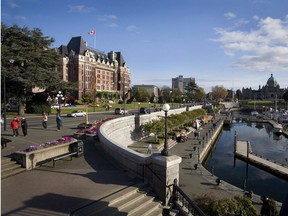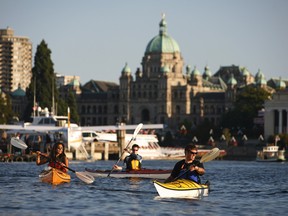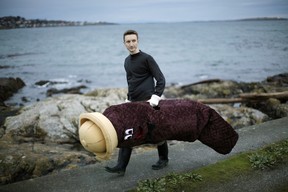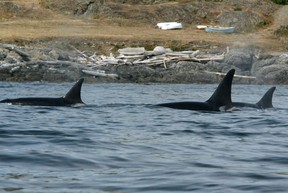Easy Pictures to Draw of Sewage to the Ocean
Leave Victoria's 'raw sewage' alone, Alberta
Vilification of Victoria's 'raw sewage' has been driven by a combination of politics, fear and emotional appeals. Sound familiar?

As B.C. continues to stand in the way of the Trans Mountain expansion, it has recently become very popular for Albertans to call out the province's "hypocrisy" of standing up for the ocean while simultaneously dumping raw sewage in the Pacific.
"B.C. has been dumping raw sewage in its waterways for years, but are threatening Confederation because of SAFE, DOUBLE HULL, tankers delivering Alberta resources to market," reads a recent tweet from Brian Jean, former leader of Alberta's Wildrose party.
"Untreated sewage" in B.C. was also the focus of a recent column by another former Wildrose leader, Danielle Smith. It also got a web mention from David Egan, a board member with the province's United Conservative Party.
But of all the hypocritical environmental things to call out about the West Coast (here's one, here's another one), sewage is not one of them. As counterintuitive as it may seem, the whales and salmon are almost completely unharmed by B.C. Premier John Horgan's toilet flushing directly into the ocean.
In fact, in a pattern that Albertans might find familiar, the decades-long vilification of Victoria's "raw sewage" has been driven almost exclusively by a combination of politics, fear and emotional appeals from environmental activists.
"There are no major human health concerns associated with the sewage discharge," reads a 2006 editorial co-authored by nine Victoria ocean scientists and published in the journal Marine Pollution Bulletin.
Every day, Greater Victoria generates roughly 130 million litres of sewage that finds its way to the Pacific Ocean.

The sewage is first filtered through mesh screens to remove tampons, used condoms and other solids, so it's not entirely "raw." Then, the sewage is pumped into outfall pipes that vent roughly one kilometre offshore, 50 metres below the surface.
The practice would be an environmental disaster almost anywhere else, but in the fast-moving waters of the Juan da Fuca Strait, the effluent is quickly dispersed by tidal currents.
The secret ingredient is dilution. It's the difference between smoking a cigar on the deck of a ship or in a crowded elevator. Victoria's sewage is so quickly diluted by ocean currents that if scientists aren't taking their measurements directly around the outfall pipe, they have repeatedly failed to find compelling evidence of harmful pollution.
"Overall, the impact of the outfall on the sediments is minimal, highly restricted in extent, and not of major environmental concern," concluded a 1993 study examining the pollution around the outfall pipes.
Where contamination existed, it was found to be restricted to within 400 metres of the outfall pipe, and was in some ways comparable to the pollution emitted by a sunken 1891 coal ship that happened to be in the area.

In 2006, a blue ribbon panel was convened to determine the environmental need for a sewage treatment plant in Victoria. Their final report concluded that "the benefits of treatment cannot be described or calculated with any precision."
The outfall sites are not recommended for snorkelling, to be sure, but they are far from being toxic wastelands of marine death.
A 2015 analysis by Victoria's Capital Regional District notes that researchers did find harmful concentrations of heavy metals near the outfall pipe, but that these all disappear at distances of 400 metres. Even on the surface of the ocean directly above a sewage outfall, "risks to human health were still considered low," it read.
In 2011, another sediment analysis by outside consultant Golder Associates also found contaminants near the outfall pipes, but not enough to indicate "toxicity or other biological responses."
Most recently, a 2017 study looked at contamination caused by pharmaceuticals and personal care products around the outfall pipes. Like the other studies, there was detectable pollution at the immediate outfall point, but no evidence of anything widespread.
In fact, only 200 metres away from the outfall sites, the rate of pollution had dropped so low that it was roughly the same as it would be if Victoria's sewage was being piped into the ocean after conventional sewage treatment.
As one paper from the University of Victoria put it, not all "receiving environments" are created equal, and Victoria's is particularly robust at dealing with human waste. "Strong tidal currents and the cold, well-oxygenated waters of Victoria's marine environment give these waters a high assimilative capacity for organic waste," it read.
Despite all of this, calls for a sewage treatment plant have never abated, and have been driven largely by political factors.
Environmental activists warned of non-existent fish kills. A group calling itself People Opposed to Outfall Pollution (POOP) took to parading around "Mr. Floatie," a large mascot of a turd — even though due to primary screening of Victoria's sewage, real "floaties" are never discharged by Victoria.

Sewage fears caused Washington State to organize a tourism boycott of Victoria in the 1990s. In 2014, Washington Governor Jay Inslee drafted an official reprimand accusing Victoria of ruining their shared waters.
And in 2006 the issue came to a head when B.C.'s then-environment minister Barry Penner ordered the city to draw up plans for a secondary sewage treatment plant. "No pun intended, but it's a very Victorian-era approach; it may be what was done in the 19th century, but we're now in the 21st century," Penner said in 2016.
These were later joined by federal orders from the government of Stephen Harper that Victoria would need to install secondary treatment of its sewage by 2020.
Construction is now underway on a treatment plant for Victoria that will cost an estimated $765 million. Add in operating costs and interest charges, and the total cost could end up exceeding $2 billion.
"If you want to spend a few hundred million dollars on protecting the marine environment, this would be way, way down the shopping list," Chris Garrett, a retired University of Victoria oceanographer, told the National Post in 2013.

For decades, one of the most vocal opponents of sewage treatment for Victoria was Ted Dew-Jones. A veteran of sewage treatment design in his native England, he was the engineer who approved Victoria's current system of long outfall pipes — and then watched as years of monitoring failed to find any adverse effects.
He quit in protest from B.C.'s Pollution Control Branch in 1985 just as he said "politicians were getting involved" in the sewage question. Six years later, he published Victoria's Sewage Circus, his account of the political pressure on environmental authorities to find even the slightest reason to justify a treatment plant.
"It had some influence, but it didn't really stop it, so here we still are, fighting away," he said in a 2016 interview. Dew-Jones died in 2017 at age 92.
Among opponents of a treatment plant, their argument has consistently been that there's nothing a sewage plant can do that isn't currently being performed just as well by the Juan da Fuca Strait.
"It makes no sense to replace a natural ecosystem service with a human creation that is energy-inefficient and has other harmful environmental consequences," the nine ocean scientists wrote in their 2006 editorial in Marine Pollution Bulletin.
David Anderson is a former federal environment minister. A retired Victoria MP, he still lives in the city and his toilet indeed connects to the outfall pipes. He's long been a loud critic of Victoria's march towards a sewage treatment plant, at times calling it evidence of "how far this country has moved (from) science-based public policy."
As he joked in a 2016 interview, "you have to be a little disappointed; these people elected me and they clearly have not been acting rationally on this issue."
• Twitter: TristinHopper | Email: thopper@nationalpost.com
Source: https://nationalpost.com/news/canada/leave-victorias-raw-sewage-alone-alberta

0 Response to "Easy Pictures to Draw of Sewage to the Ocean"
Post a Comment